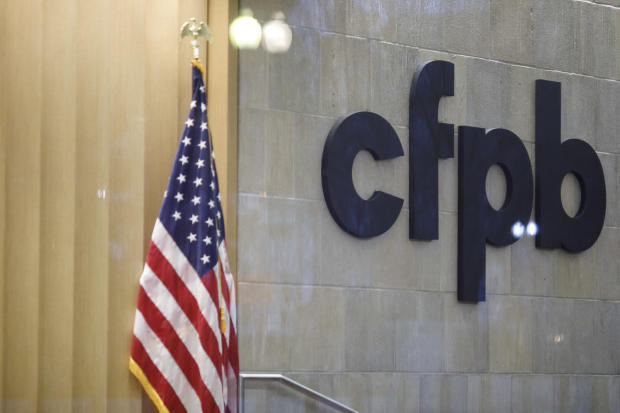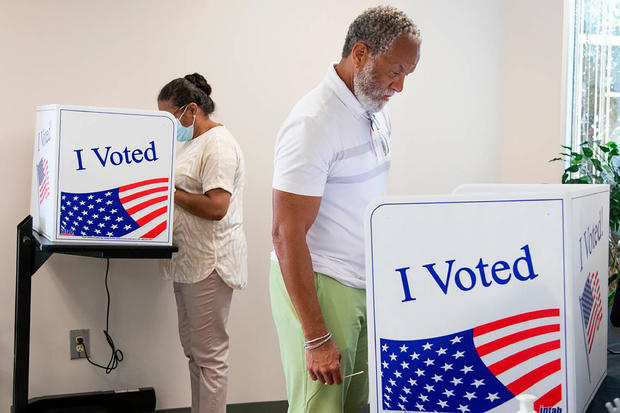Supreme Court begins new term with battles over agency power, guns and online speech
Washington — Supreme Court justices are returning to the bench Monday for the start of a new term after a summer recess throughout which questions swirled about the justices' adherence to ethics principles.
On the docket for the justices in the upcoming term, which runs through June 2024, are cases involving the First Amendment, administrative power, and gun rights. Also set for action from the high court is a closely watched request for it to decide the rules for obtaining the widely used abortion pill mifepristone, a challenge to the federal ban on bump stocks originating from the Trump administration, and potentially, a review of school rules that prohibit transgender students from using the bathroom that matches their gender identities.
If the Supreme Court agrees to take up the Justice Department's appeal in the dispute over mifepristone, it would be the first case involving abortion heard by the justices since a conservative majority overturned Roe v. Wade in June 2022. A decision restricting the rules surrounding the drug's use would impact abortion access nationwide, even in states where it is legal.
Looming over the docket is scrutiny of the ethics policies that the justices adhere to following a series of reports from ProPublica about Justices Clarence Thomas and Samuel Alito's ties to wealthy Republicans. At least two of the justices, Elena Kagan and Brett Kavanaugh, have publicly suggested that they are working behind-closed-doors to address recent ethics concerns, and Chief Justice John Roberts said in May that the justices "are continuing to look at the things we can do to give practical effect" to their commitment to the highest ethical standards.
"This term will give us more evidence to try to assess what kind of court this is: is it a 6-to-3 divided court or is it as many suggest a 3-3-3 court, with the three Democratic appointees, three very extreme conservatives in Alito Thomas and Gorsuch, and three sort of in the middle who determine results, Roberts, Kavanaugh and Barrett," David Cole, national legal director of the American Civil Liberties Union, during a briefing with reporters about the upcoming term.
The First Amendment
The term set to kick off Monday is the first in recent years that does not include a case involving religious liberty, but several that will be heard by the justices involve free speech rights.
Two of the disputes involve how elected officials interact with the public on social media, and specifically whether they engage in state action subject to the First Amendment when they block users from personal social media accounts that are used to share job-related information with the public.
"In a sense, this is the new context for the always puzzling problem of what hat are you wearing? Are you actually functioning as a government official here or are you actually functioning as a private person?" said Nicholas Quinn Rosenkranz, a law professor at Georgetown University, at an event hosted by the Federalist Society, a conservative legal organization.
The issue of whether elected officials are crossing a constitutional line when they block followers who mount criticisms on Facebook and X, formerly known as Twitter, was at the center of a lawsuit brought against Donald Trump in 2017, when he was president. A federal appeals court found that Trump violated the First Amendment when he blocked online critics of his policies, and he asked the Supreme Court to review the decision in 2020.
But the high court ordered the case to be thrown out in April 2021, after Trump left office, leaving unresolved the question of where is the legal line for government officials when they interact with constituents — or take steps not to — on social media.
The justices are poised to provide some clarity this term with the cases involving two California school board members, and a city manager from Michigan, which they'll hear Oct. 31.
"Everyone agrees that the local government officials in these cases are obviously government officials, but they also are private individuals with their own private lives, and in their private capacities, they are entitled to First Amendment freedoms just like the rest of us," Evelyn Danforth-Scott, a staff attorney with the American Civil Liberties Union, told reporters. "This is really a case about how we distinguish between public officials' public and private capacities in the digital space where those boundaries are more porous than they may have been in the pre-digital era."
Though Trump is no longer in office, he's also at the center of a trademark dispute the high court is set to hear Nov. 1, which involves a California lawyer's unsuccessful effort to trademark the phrase "Trump Too Small." The phrase is a nod to a memorable exchange between then-presidential candidates Trump and Sen. Marco Rubio in 2016, when Rubio mocked Trump for having small hands.
Lawyer Steve Elster applied to register the trademark "Trump Too Small" with the U.S. Patent and Trademark Office, but the agency refused to do so under a provision of federal trademark law that bars the registration of any trademark that includes the name of a living person unless they give written consent. An examiner with the office also denied registration under a section of the law that bars registration of marks that falsely suggests a connection with a living or dead person.
Elster argued two provisions of the law, the Lanham Act, were unconstitutional, and the U.S. Court of Appeals for the Federal Circuit said applying the provision requiring written consent unconstitutionally restricted his right to free speech.
The battle follows two recent cases brought after trademark denials, which resulted in the Supreme Court invalidating neighboring provisions of the Lanham Act. One case, Matal v. Tam, involved a band's request to trademark the name "The Slants." The application was denied after the trademark office said it ran afoul of the Lanham Act's prohibition of disparaging trademarks. The other case, Iancu v. Brunetti, arose from an attempt to register the trademark "FUCT," a clothing brand. The government refused to register the mark under a section of the Lanham Act barring the registration of "immoral" or "scandalous" marks.
"The government's problem is trying to explain why this is different and why the statute should survive with this provision, and I think it's an uphill battle for them to distinguish it is," Rosenkranz said of the challenge facing the Biden administration.
Just before the new term begins, the court agreed to consider a pair of cases from Texas and Florida that arose from challenges to state laws imposing new rules on big social media companies. The laws were passed in response to claims from Republican lawmakers that platforms like Facebook and X censored conservative viewpoints, and they seek to regulate content-moderation policies.
The legal battle involving the government's efforts to address the spread of misinformation on social media is the latest before the justices that stand at the intersection of the First Amendment and online speech.
The Second Amendment
One of the closest watched disputes before the Supreme Court this term follows a June 2022 decision in which the court's conservative majority expanded the scope of the Second Amendment and imposed a new standard for lower courts to apply when deciding whether firearms restrictions are within the bounds of the Constitution.
In the 2022 ruling in New York State Rifle and Pistol Association v. Bruen, the court said the government must show a law is consistent with the nation's historical tradition of firearms regulation and can justify a restriction by identifying historical analogues.
The case to be heard this term, on Nov. 7, involves a law that prohibits people subject to domestic violence restraining orders from having guns. The plaintiff, Zackey Rahimi, was under a restraining order granted to his former girlfriend in February 2020 when he threatened another woman with a gun and was involved in a series of five shootings in December 2020 and January 2021.
When police searched his home, they found a .45-caliber pistol, a .308-caliber rifle, magazines and ammunition.
Rahimi was charged with violating the federal law barring gun possession by people under domestic violence restraining orders, and sought to dismiss the indictment, claiming the 1994 law violated the Second Amendment. A federal appeals court eventually found the law to be unconstitutional, as the government failed to meet its burden of showing it is "consistent with the nation's historical tradition of firearm regulation."
The Justice Department appealed to the Supreme Court.
"The real legal question that everyone is interested in with Rahimi is to see how the court clarifies and applies the text, history and tradition test that it had announced two terms ago in Bruen," said Robert Leider, a law professor at the Antonin Scalia Law School, at the Federalist Society event. "Unquestionably the government sought review in this case to water down the test."
Leider predicted that given the facts surrounding Rahimini's case, the court could "duck a lot of the hard issues if it wants to" and leave them for another day.
Joseph Blocher, co-director of the Duke Center for Firearms Law, said he expects to see more thought from the justices about what constitutes a historical tradition and what forms of evidence count for that purpose.
"The court can give some better guidance about what it means to find a historical analogue, at what level of generality to ask the questions," he told CBS News. "Maybe rather than looking for a specific historical law disarming people who are subject to a domestic violence restraining order, courts should be looking for historical laws disarming people thought to be dangerous. Those are both historical inquiries, but the second one has a broader aperture."
Separate from the Rahimi case, the Justice Department is also poised to ask the justices to take up a case involving the Gun Control Act's ban on firearm possession for felons. The U.S. Court of Appeals for the 3rd Circuit invalidated the felon-in-possession law in a challenge brought by a Pennsylvania who admitted in 1995 to making a false statement to obtain food stamps in violation of state law.
Leider noted that there are between 5,000 and 6,000 cases on the federal docket per year where the felon-in-possession law is the lead charge, compared to roughly 30 cases each year for the domestic violence restraining orders prohibition.
"Mr. Rahimi is the poster child for irresponsible gun possession," he said, "and I think the government wanted this case and not the welfare-fraud case because it views this case as much easier on the judgment line even though as far as the day-to day-business is concerned, the felon-in-possession cases are much more significant."
Agency power
Following two consecutive terms in which the Supreme Court rolled back the nationwide right to abortion, expanded Second Amendment rights and barred higher education institutions from considering race as a factor during the admissions process, the justices are hearing numerous cases this year involving administrative law.
"This term is an administrative law professor's dream," said Jennifer Mascott, a law professor at the Antonin Scalia Law School at George Mason University, during the Federalist Society event.
The most significant of these cases, a dispute between the Biden administration and the commercial fishing industry, presents the high court with a chance to overrule a nearly 40-year-old decision and curb the authority of federal agencies.
The case, Loper Bright Enterprises v. Raimondo, involves a 1976 law that governs management of marine fisheries in federal waters and requires at least one federal observer to be on board domestic fishing vessels when they're at sea.
Four family-owned and operated fishing companies in the Atlantic herring fishery sued the federal government in 2020 over the at-sea monitoring requirements and alleged the National Marine Fisheries Service did not have the authority to mandate industry-funded monitoring in the herring fishery.
The U.S. district court in Washington ruled in favor of the government, citing the long-standing doctrine known as Chevron deference, which stems from the 1984 Supreme Court decision in Chevron v. National Resources Defense Council. The high court said in that ruling that courts should defer to an agency's reasonable interpretation of statutes when they are ambiguous.
A divided three-judge panel of the U.S. Court of Appeals for the District of Columbia Circuit agreed, concluding after applying the Chevron framework that the National Marine Fisheries Service acted within the scope of its statutory authority when it adopted a plan that mandates industry-funded at-sea monitoring.
The fishing companies appealed to the Supreme Court and asked the justices to overrule Chevron "or at least clarify that statutory silence concerning controversial powers expressly but narrowly granted elsewhere in the statute does not constitute an ambiguity requiring deference to the agency."
Mascott said the latter part of the question gives the justices a "back door," in which the high court could decline to outright overrule 40-year-old precedent but clarify whether silence in a statute constitutes ambiguity.
"All of these questions actually are independently arguably of really significant import about the constitutionality of how a branch of government that has many, many agencies engaging in many, many areas of authority operates," she said.
Arguments in that case have yet to be scheduled.
Another closely watched dispute, which the justices will hear Tuesday, involves the mechanism for funding the Consumer Financial Protection Bureau, which has been in the crosshairs of conservatives since its creation in 2010.
While most federal agencies and departments are funded by Congress through the annual appropriations process, the CFPB is funded by the Federal Reserve, as laid out in the Dodd-Frank Wall Street Reform and Consumer Protection Act. The law, which created the bureau, stated that the CFPB's funds "shall not be subject to review" by congressional appropriators.
Two trade associations sued the CFPB over a 2017 payday lending rule and alleged in part that the agency's funding mechanism is unconstitutional because it improperly insulated it from congressional supervision. A three-judge panel of the U.S. Court of Appeals for the 5th Circuit found the funding scheme violates the Constitution's appropriations clause, which states "no money shall be drawn from the Treasury, but in consequence of appropriations made by law."
The Biden administration asked the Supreme Court to review the 5th Circuit's ruling, warning that it "calls into question virtually every action the CFPB has taken" since its creation more than a decade ago.
"These cases are getting at arguably more systemic questions even about how Congress and the executive branch interact and the substance and form of how agencies are acting," Mascott said.
Voting rights
After the court split 5-4 in an unexpected decision involving the congressional map drawn by Alabama Republicans, the Supreme Court took up a battle over the lines for South Carolina's 1st Congressional District, which gave Republicans an edge.
Voting rights groups challenged the congressional map drawn in 2021, alleging in part that the bounds of District 1 were racially gerrymandered and intentionally drawn to dilute the power of Black voters. A three-judge federal district court panel agreed and said the district constituted a racial gerrymander because race was the predominant factor in the adoption of the redistricting plan.
The justices will hear arguments Oct. 11, and South Carolina Republicans urged the court to issue a decision by Jan. 1 to ensure there is clarity for the 2024 election cycle. South Carolina's Democratic primary election is set for Feb. 3, and the Republican primary will take place Feb. 24.
"Black voters in Congressional District 1 have already had to vote under this unconstitutional congressional map once," said Sophia Lin Lakin, director of the ACLU's Voting Rights Project, referencing the 2022 elections. "They shouldn't have to endure that yet again in another election."
Lakin said the case involves a "straightforward application" of a 2017 Supreme Court decision, Cooper v. Harris, in which the justices said race cannot be used as a proxy for political behavior.
Cole, the ACLU's national legal director, noted that while the Supreme Court has said racial sorting is not permissible, partisan sorting is effectively allowed because federal courts can no longer decide claims of partisan gerrymandering following a pair of Supreme Court rulings in 2018.
"In many parts of the country, race and party overlap, and so how do you disentangle the prohibition on racial sorting and the permission for partisan sorting?" he said, adding that South Carolina officials have argued they engaged in sorting by party, not race. "That issue of disentangling race and politics will continue to be a major one for the court on voting rights cases."






